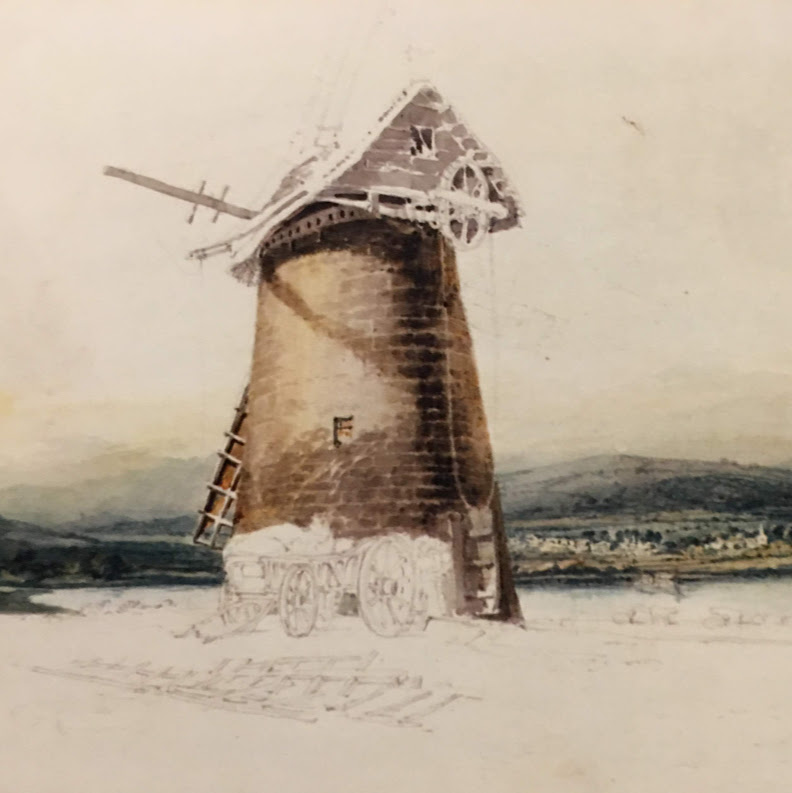Patience. The windmill never strays in search of the wind.’ Andy J. Sklivis

It’s been the perfect weather for ice-cream this past couple of weeks. The summer days have been long and gloriously warm. On our hill, 35 metres above the once-watery Bembridge Marshes, the breeze has kept the heat at bay. Still, the passers-by have systematically emptied the freezer of Magnums, Cornettos and tubs of local ice-cream. Standing on the hill at the back of Bembridge, our windmill looks across the valley to Bembridge Down and the Culver Inn, the sky between splashed with whispy cloud, tiny microlight planes, buzzards and swallows. Recently three pairs of Sea Eagles have been re-introduced to the island, but I’m yet to catch a glimpse.
This summer, I have been volunteering two days a week at the National Trust windmill, and I have become quite the anorak when it comes to its history and its workings. I have read all the literature, watched the documentary, and learned more from our visitors than all the rest put together. For instance, do you know why there are two pairs of grinding stones? Weighing half a ton each, the stones were made from either French Burr Stone, best for producing high quality flour, or Derbyshire Millstone Grit that was acceptable only for turning out rougher animal feed. The runner stone would be carved with a pattern of ‘furrows and lands’ designed to crush and cut the grain as it ran over the bed stone. This runner stone needed redressing every ten days, or after grinding about 400 tons of grain, whichever came first. As dressing the stones could take the stonemason many hours of work, a mill would generally have at least two pairs, so that one set could always be working while the other was being dressed. The current stones came from the Wootton Bridge water mill that closed down in 1945 and was demolished in 1962. But how does a watermill work? Another visitor was able to fill me in. There is also a miniature pair of stones with a handle like a pestle that can be turned by hand, so children can explore how real millstones grind the wheat into flour. (The kids also get to hunt for six small Homepride millers in their retro black bowler hats and find answers to the nature trail along the back fence.)

Windmills became popular in Europe in the 14th century, and although they were never as popular as water wheels, they could be used in regions with little water. Or, like in Holland, where a level landscape prevents a strong flow of water. With the coming of the industrial revolution, both water and wind as a source of power were upstaged by steam and combustion engines. As an island that seems to have skipped the industrial revolution and remains largely rural to this day, it is hardly surprising that the Isle of Wight has a history of myriad mills: windmills, watermills, and tidal mills. All designed to use natural power to grind wheat into flour.
Bembridge Windmill is the only surviving windmill on the Isle of Wight. It is a tower mill – a stone structure on which only the wooden cap and sails rotate – built in the early 18th century. Although no one is quite sure of the exact date, we know it was up and running from 1747, which date is engraved into a step. Developing on from the original wooden windmills, where the whole structure could turn on an axel? towers could be built higher – ours is 10m high – and sails (or sweeps as they are known locally) could be longer, and therefore pick up even the lightest breeze. For two hundred years Bembridge Mill was in constant use, despite the growth of steam powered mills on the mainland by the late 19th century. In 1913 it finally ground to a halt, and during the subsequent war years it became derelict, although serving as a lookout for the home guard.
Europe was once flush with mills, as so many landscape paintings testify. Dutch painters, understandably, seem to have painted little else. Then, think of Monet or Constable, who both displayed a bit of a fetish for a mill. Yet, as the industrial revolution took a firm grip on Europe, engineers learned to harness steam and coal instead of wind and water. By the early 20th century, many mills had fallen out of use. Without use or maintenance, these fine old structures gradually became derelict and hundreds were simply demolished. Also, flour is surprisingly combustible, so many wooden mills accidentally burnt to the ground. (It was also a visitor who explained how this happened and filled me in on any number of mill fires.)
While many mills burned down, others were converted into unusual homes. A few wise souls saw the worth of preserving this fascinating part of our rural heritage, with the help of photographs and drawings by the likes of architect J. Kenneth Major was an architect. Others sought simply to immortalize them with pen or paintbrush.
In the eighteenth and nineteenth centuries, it became highly fashionable for the English aristocracy to travel around the Isle of Wight. Painters and writers came in droves, capturing much of the island landscape and lifestyle on canvas and paper. The pastoral landscape of the island remains today, but the coastal towns have changed dramatically since the nineteenth century, from small fishing villages to popular health spas and holiday resorts.

JMW Turner returned several times to the island, to sketch and paint. An original Turner oil painting of Carisbrooke Castle now hangs in the Great Hall there. His sketch book containing some two hundred and forty black and white sketches of his trips around the Isle of Wight still exists at the Tate, and beautifully captures a significant era of the island’s history. It includes at least one of our windmill, a copy of which hangs in the National Trust hut at the property.
Currently, the sweeps lie on the ground against the fence, as they did in Turner’s sketch, while the Trust raises money for new ones. Unfortunately, even when the sweeps are fixed and turning, flour is no longer produced here. The nearest working National Trust mill is at Winchester, and we have sample bags of its flour for sale in our tiny shop, along with some recipe cards, and a lovely little cookery book chock-a-block with scone recipes for those with any skill for baking. I have to admit, after many disastrous experiments, that will never be me, but I did hear from a visitor yesterday that the cook at The Needles Battery makes the best scones she has ever tasted, so I’m off to the other end of the island for afternoon tea…
